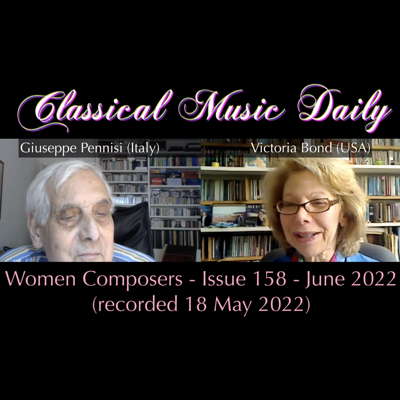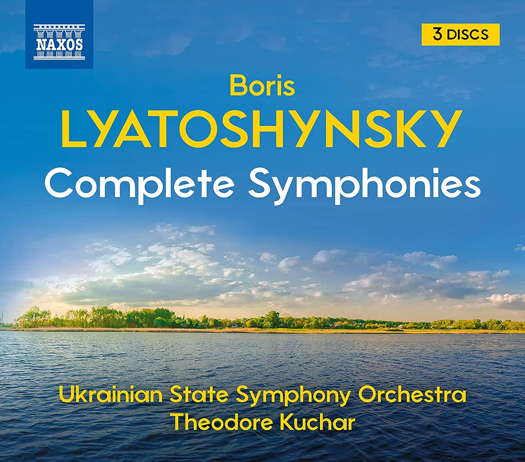 DISCUSSION: What is a work? John Dante Prevedini leads a discussion about The performing artist as co-creator, including contributions from Halida Dinova, Yekaterina Lebedeva, Béla Hartmann, David Arditti and Stephen Francis Vasta.
DISCUSSION: What is a work? John Dante Prevedini leads a discussion about The performing artist as co-creator, including contributions from Halida Dinova, Yekaterina Lebedeva, Béla Hartmann, David Arditti and Stephen Francis Vasta.
 VIDEO PODCAST: Women Composers - Our special hour-long illustrated feature on women composers includes contributions from Diana Ambache, Gail Wein, Hilary Tann, Natalie Artemas-Polak and Victoria Bond.
VIDEO PODCAST: Women Composers - Our special hour-long illustrated feature on women composers includes contributions from Diana Ambache, Gail Wein, Hilary Tann, Natalie Artemas-Polak and Victoria Bond.

Interesting and Quite Unique
GEOFF PEARCE commends this set of orchestral music by Ukrainian composer Boris Lyatoshynsky
'There is some very impressive playing here by this magnificent orchestra.'
I was waiting eagerly for this set as Boris Lyatoshynsky was not a composer I previously knew of, but in his home country he is widely regarded as the father of modern Ukrainian music. Theodore Kuchar is a fine conductor and I was privileged to play in an orchestra under his direction in the mid 1970s in New Zealand, and was impressed with his clear conducting style and impressive musical knowledge. He is also a fine viola player and has been particularly active in the performance and promotion of chamber music.
Lyatoshynsky's music falls basically into three periods. The first period, full-blown romantic in style, lasted until the 1920s, and not surprisingly his musical style reflected the tastes of his teacher, Reinhold Glière. Around the time of the first symphony being composed, one of his strongest influences was Scriabin. Shortly after the composition of this symphony, Lyatoshynsky became interested in the second Viennese school, particularly in the music of Alban Berg, and this lasted until 1929 when he began to explore his Ukrainian music heritage. From the late 1920s, however, Stalin brutally repressed anything remotely resembling Ukrainian nationalism in favour of Soviet realism. It was not really until after Stalin's death that modernism and Ukrainian influences could be safely explored and developed in music again, and many of Lyatoshynsky's students were at the forefront.
The first Symphony, completed in 1919 and first performed in 1923, is a substantial three movement work. To my ears, the influence of Scriabin is very important and the music is erotically romantic, sometimes using the orchestra's full forces to deliver some quite shattering climaxes. At other times, the forces are reigned in to provide relief and contrast.
Listen — Boris Lyatoshynsky: Molto lento (Symphony No 1 in A)
(8.503303 CD1 track 2, 8:24-9:24) ℗ 1994 Naxos Rights US Inc :
Immediately I was struck with what a fine orchestra this is, and the symphony itself is colourful and original. I found it an enjoyable work to listen to. In the third movement, I felt the influence of Tchaikovsky, Glière and perhaps even Rachmaninoff. I do hope this work becomes more widely heard.
Listen — Boris Lyatoshynsky: Allegro energico (Symphony No 1 in A)
(8.503303 CD1 track 3, 0:00-0:51) ℗ 1994 Naxos Rights US Inc :
The symphonic ballad Grzhyna is one of the composer's finest and was written in 1955. It is based on an epic poem by Adam Mickiewicz telling of a Ukrainian princess who battled and was later killed by the Teutonic knights after disguising herself as her husband and leading the troops into battle. This work lasts for nineteen minutes. It opens with murmuring strings, and a solo cor anglais provides the melodic interest. This is followed by a faster, militaristic section, perhaps a call to arms, before subsiding to a development of the opening employing fuller forces and it is quite rhapsodic and emotionally charged in nature. This is followed by a grand section which starts in an almost processional nature but gradually becomes more heated and restless, and has a section of rising sequences which adds to the excitement.
Listen — Boris Lyatoshynsky: Grzhyna
(8.503303 CD1 track 4, 10:44-11:32) ℗ 1994 Naxos Rights US Inc :
Towards the end, the music slows down. Firstly there is a series of chordal calls in the brass, and the opening mood returns, but in a kind of solemn funeral procession. This is quite an exciting and varied piece of music, and is certainly one that will resonate with most listeners, given the current situation in Ukraine. The music is romantic in nature, but I feel the influence of Scriabin is absent from this later work. I have to mention the very fine cor anglais playing which features a lot in this work. Perhaps this is a depiction of the voice of Grzhyna herself.
Listen — Boris Lyatoshynsky: Grzhyna
(8.503303 CD1 track 4, 17:17-18:04) ℗ 1994 Naxos Rights US Inc :
The three-movement second symphony was composed in 1935-36, but did not receive its first public performance until nearly thirty years later, due to condemnation by the Soviet censors of the time. It is a brooding work, full of power and full-blooded orchestral writing, especially in the outer two movements, which are quite emotionally tumultuous. The second movement is slow and Alla ballata, with a brooding reflective tune introduced by the cor anglais - an instrument the composer features and writes very effectively for. Whilst the music here is lush and romantic in sound, I sense at times a feeling of unease in the outer two movements. The final movement alternates between a slow, broad theme and a much faster, edgy one.
Listen — Boris Lyatoshynsky: Andante - Allegro precipitato (Symphony No 2)
(8.503303 CD2 track 3, 0:19-1:09) ℗ 1993 Naxos Rights US Inc :
The Third Symphony, regarded by many as Lyatoshynsky's finest, was completed in 1951, but because the Soviet censors were not happy with it, the composer, as he wanted the work to be performed, had to revise the work in 1954, and it was not until the following year that it was given its first performance. Since then, it has become the most widely performed of his symphonies. The performance this symphony receives on this recording is truly one to be inspired by. The music often changes mood and direction, but the composer writes with conviction, and one can easily follow the musical thought and admire his skill. I can understand why this symphony is highly regarded and will be a work I'll often listen to with great pleasure. It is quite a long symphony, in four movements, lasting over forty-six minutes, but I was fully engaged throughout.
Listen — Boris Lyatoshynsky: Allegro risoluto (Symphony No 3)
(8.503303 CD2 track 7, 7:04-7:51) ℗ 1993 Naxos Rights US Inc :
The Fourth Symphony, composed in 1963, is in many ways the most innovative of Lyatoshynsky's symphonies. Whilst the composer has not discarded tonality, and the key ascribed to the work is B flat minor, tonality is certainly stretched in many places. This work is in three contrasting movements and is certainly very different from Lyatoshynsky's other symphonies, sounding distinctly more 'modern'. The first movement, for the most part, is intense and resolute, and like all of his works shows his complete mastery of orchestration. There is some very impressive playing here by this magnificent orchestra. The last third of the first movement slows down, becoming significantly calmer, and this leads into the slow and rather ominous sounding second movement, initially relying a lot on the lower instruments of the orchestra, giving the music a subterranean feeling.
Listen — Boris Lyatoshynsky: Lento tenebroso - Andante (Symphony No 4)
(8.503303 CD3 track 2, 1:43-2:32) ℗ 1993 Naxos Rights US Inc :
Tension mounts as higher instruments and glittering percussion are added. A faster section occurs just over half way through, but the tone is still somewhat ominous. The last movement begins sounding frenetic and nervy. This eventually dissipates into a calmer section before retuning again, before finally subsiding and ending serenely.
The final symphony, No 5, a three movement work, composed in 1965-66, is subtitled Slavyanskaya (Slavonic). It is inspired by the folkloric hero Ilya Muromets from the twelfth century Kievan Rus. This character is important in the region, and is the subject of folk songs, paintings, an opera, and was also the subject of Glière's Third Symphony. Lyatoshynsky's work uses a number of folk tunes from various countries, including Russia, Yugoslavia and Bulgaria, and they appear in various guises at different times during the work, which does not attempt to depict the major events of Muromet's life, but is more a reflection on some of these events, and an overall reflection on the universal bonds that unite all Slavs. Again present through this work is the evidence of a mastery of orchestration, skill in the utilisation of contrapuntal elements, an overall gift for colour and melody and an absolute conviction in his unique voice.
Listen — Boris Lyatoshynsky: Moderato - Allegro energico (Symphony No 5 in C)
(8.503303 CD3 track 6, 0:00-0:47) ℗ 1993 Naxos Rights US Inc :
This is a very worthwhile set to have: the music is interesting and quite unique, and the orchestra is very good indeed, under the direction of Theodore Kuchar, a widely recorded and much lauded conductor. He is meticulous in his attention to detail, and assists his very able band to get the very best from this lesser-known composer who deserves much wider exposure. At the very least, this is a set that should be on your listening list. It comes with comprehensive notes in all three discs, and this is to be commended.
Copyright © 4 July 2022
Geoff Pearce,
Sydney, Australia

CD INFORMATION - BORIS LYATOSHYNSKY: COMPLETE SYMPHONIES
CLASSICAL MUSIC ARTICLES ABOUT UKRAINE


